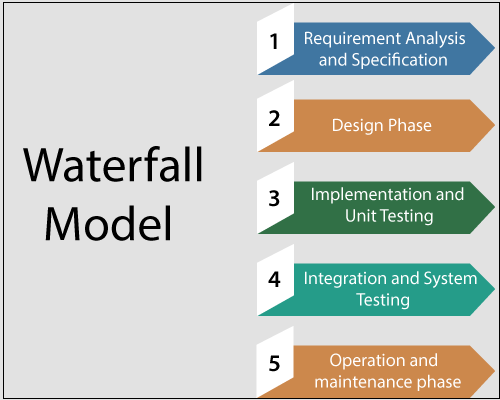Waterfall Model in Software Engineering
The most popular model is the waterfall model. This model has five phases:
- Requirement analysis and specification
- Design
- Implementation & unit testing
- Integration and system testing phase
- Operation and maintenance
These phases often occur one after the other. The developer should complete each step before the next phase starts. This model is called the "Waterfall Model" because its diagrammatic representation resembles a waterfall.

Requirement analysis and specification phase:- This phase aims to understand and properly document the exact requirements of the customer. This task is usually carried out in collaboration with the customer, as the aim is to record all features, functionality, and configuration specifications for the application. The requirements describe the "what" of the system, not the "how" of the system. This process produces a large file, written in a natural language describes what the program will do without explaining how it will be accomplished. The resultant document is known as a software requirement specification (SRS) document.
The SRS document may act as a contract between the developer and the customer. If the developer fails to implement a full set of requirements, it may fail to implement the contracted set of requirements.
Design phase:- The SRS document is produced in the previous phase, which contains the exact requirements of the customer. The purpose of this step is to convert the requirement specification into a structure that is suitable for implementation in some programming languages.
Hence, overall software architecture is defined, and the high level and detailed design work are performed. This work is documented and known as a software design description (SDD) document. The information included in the Software Design Description should be sufficient to start the coding phase.
Implementation and unit testing phase:- During this phase, the design is implemented. If the SDD is complete, the implementation or coding phase proceeds smoothly, because of all the information needed by the software developers contained in the SDD.
During testing, the primary activities are centered around the examination and modification of the code. Small modules were initially tested in isolation from the rest of the software product. There are problems associated with the evaluation of unit tests in isolation. How do we run a module without anything to label it, to call it, or, possibly, to intermediate output values obtained during execution? These problems are resolved at this point, and the modules are checked after writing some overhead code.
Integration and system testing:- This is a very important phase. Good testing can help to deliver higher quality software products, more happy customers, lower maintenance costs, and more accurate and reliable performance. It is a very expensive activity and consumes one-third to at least one half the value of a typical development project.
As we know, the purpose of unit testing is to determine whether each independent module is implemented correctly. It gives very little chance to determine if the interface between modules is also correct and, therefore, an integration testing is performed. System testing involves the testing of the entire system, whereas software is a part of the system. This is essential to build confidence in the developers before the software is delivered to the customer or released in the market.
Operation and maintenance phase:- Software maintenance is a challenge that every team has to face when the software is deployed and installed to the customer's site. Therefore, the release of software inaugurates the operation and maintenance phase of the life cycle. The time and effort required to maintain the operating program after launch are very important. Despite the fact it is a very challenging task, it is routinely the poorly managed headache that nobody wants to face.
Software maintenance is a very broad activity that includes error correction, enhancement of capabilities, and optimizations.
The purpose of this phase is to maintain the value of the software over time. This stage can last from 5 to 50 years, while development can last from 1 to 3 years. It is easy to reinforce the model "define before design" and "design before code" design. This model sometimes expects complete and accurate requirements, which is unrealistic. There is also no risk assessment involved.
The disadvantage of the Waterfall model
- It is difficult to define all the requirements at the beginning of a project.
- This model is not suitable for accommodating any change.s
- It's not going to scale up to large projects.
- Real projects have never been sequential.